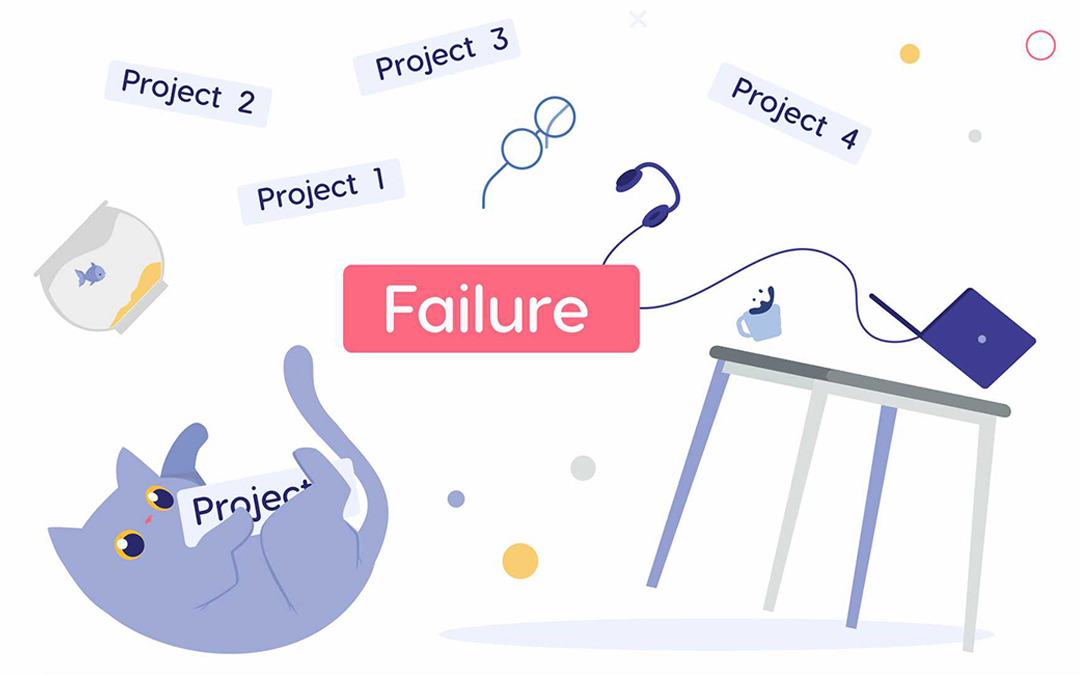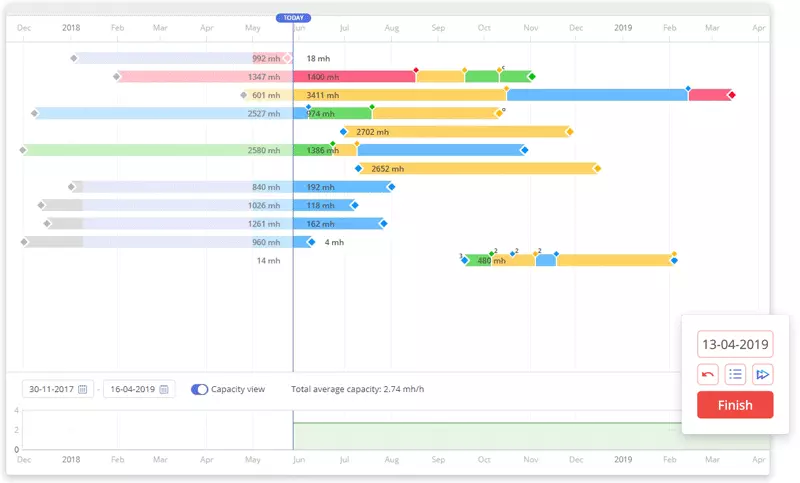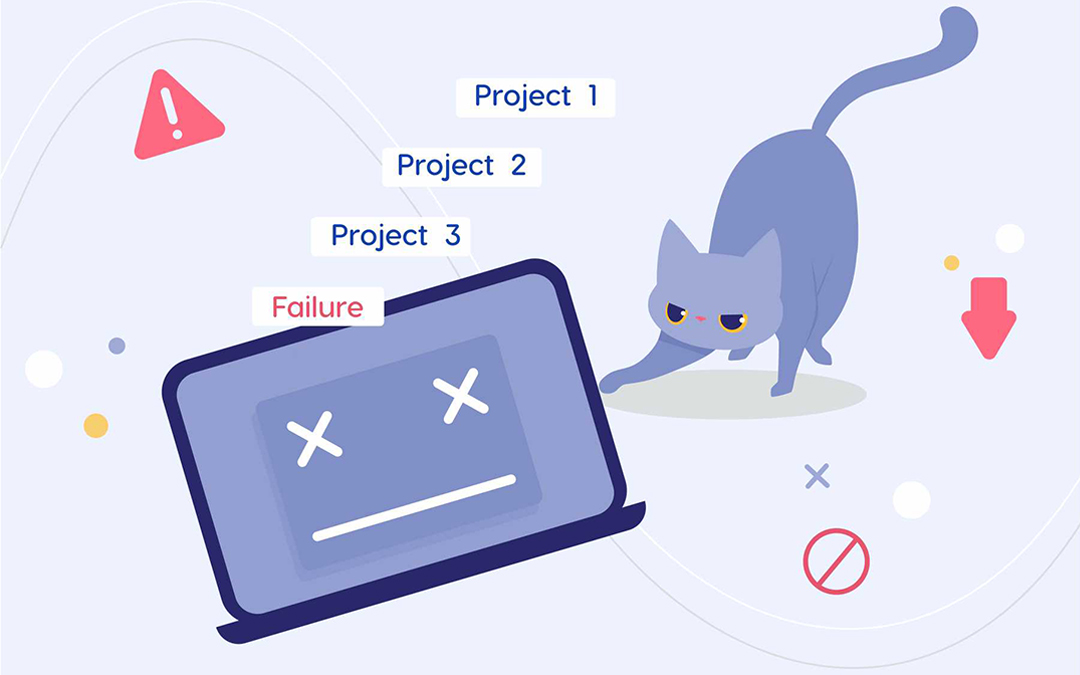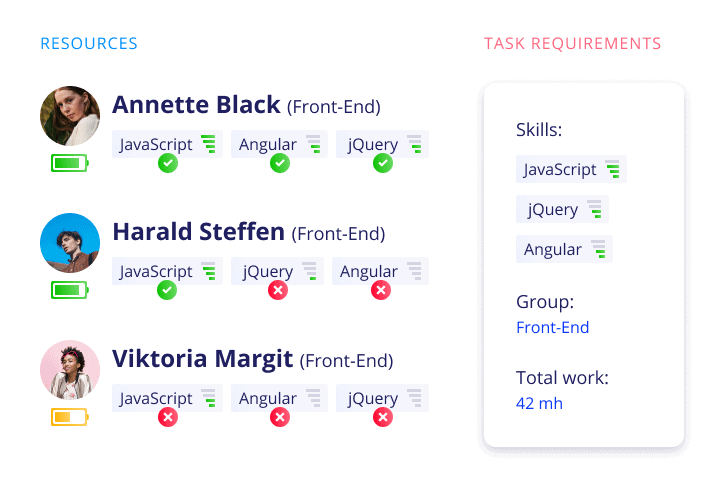Project failures don’t happen out of the blue — they’re always the result of improper management actions. In a complex multi-project environment with limited resources, the price for improper management is higher compared to managing a single project: due to dependencies between them, a problem with one project can negatively impact the other ones. So, if you manage multiple parallel projects or a project portfolio, you should be aware of the factors that contribute to project failure.
Read further to find out the most common project failure reasons and learn how to avoid project failure in a multi-project environment.
What Is a Project Failure?
A project failure is an umbrella term applicable to a variety of situations. Generally, a project is considered as a failure when it doesn’t deliver the required scope of work within the determined time and budget. But in reality, the concepts of failure and success in project management are rather ambiguous, and the decision regarding success or failure is made based a number of factors. For example, you can complete the project within the planned time frame and without budget overruns, but fail to meet customers’ expectations; in this case, it won’t be considered a success. On the other hand, it can be acceptable for project stakeholders to extend a project’s timeline and budget to get the project deliverables that fully meet their needs. In this case, a project won’t be considered as a failure despite delivering it later and exceeding the budget.
In this article, we’ll consider project failures as cases when it becomes impossible to deliver the project — e.g., there are no resources to complete the required project scope, a project is infeasible, project goals are unachievable, etc.
Let’s now proceed to examining the top reasons for project failure in a multi-project environment.
Common Reasons for Project Failure
The reasons behind project failure can be divided into three groups:
- Project management mistakes (e.g., poor project planning, scope creep, unrealistic expectations, poor communication, unrealistic goals);
- Resource management mistakes (e.g., poor resource planning, improper resource allocation);
- External factors (force-majeure circumstances).
While it’s often impossible to affect external events and their impact on projects, being attentive to common project pitfalls and avoiding mistakes that can result in project failure is quite in your hands. Here are these mistakes in more detail.
1. A lack of proper planning
However surprising it may seem, some organizations don’t create proper project plans —- their management only focuses on financial planning. But such an approach is erroneous. Planning remains crucial for determining the scope of work to complete, corresponding resource needs, cost estimates, and key risks and milestones. Without that, work on a project can turn into chaos, and the outcomes you’ll achieve will be far from desired.
There’s the other extreme when it comes to project planning — creating deterministic plans as if everything is known in advance. In a dynamic multi-project environment, this mistake may cost too much. Too many deviations from the initial plan won’t push you closer to successful project delivery, especially when you have to take into account the availability of resources involved in other projects. The likelihood of project failure in this case will increase.
2. Poor resource capacity planning
Resources are the most valuable asset of any project. But in a multi-project environment, this statement gains even more importance: people are involved in several (or more) projects simultaneously, and their work can make or break their success. So, you cannot plan projects without making sure that all the current and upcoming ones are staffed with the necessary people – you need to create a resource management plan and determine resources’ capacity. If it’s not planned properly in advance, it may turn out that the resource demand exceeds the available supply. Resource shortages will lead to the following problems:
- Cost overrun: unplanned resource shortages will result in additional hiring/outsourcing and unbudgeted expenses.
- Overwhelmed employees: an alternative to hiring new people can be increasing the workload of the available employees.
- Project delays: either hiring new people or waiting for critical employees to become available will extend a project’s duration.
In the worst-case scenario, if there aren’t enough people to deliver the estimated scope of work, and it’s impossible to hire them quickly enough, a project or several of them can fail.
Learn more about resource capacity planning from our blog post: Resource Capacity Planning: What, Why, and How
3. Improper resource allocation
Allocating resources to multiple projects is a real challenge. In a multi-project environment, this process is always accompanied by a number of difficulties, e.g., resource conflicts when employees are required by several projects at the same time; uneven workload distribution, when some team members are overloaded, while others are idle; lack of resources with necessary skills to complete project tasks, and more. At the same time, it’s the basis for fruitful project work. If resources are improperly allocated, it will result in the following issues:
- reduced productivity as a result of inappropriate workload distribution;
- resource shortages and the need to hire more people instead of optimizing the utilization of the existing ones.
When unmanaged, these problems will lead to the inability to deliver the work within the original budget and timeline and even a complete project management failure.
Read how to optimize resource allocation and make it maximum efficient in our blog post: 4 Tips on Efficient Resource Allocation in a Multi-Project Environment
4. Focusing on projects, not resources
It may seem surprising, but one of the typical mistakes in a multi-project environment is to track project progress — controlling the completion of tasks and monitoring the state of projects. Though it’s also important, when running multiple projects with a shared resource pool, the main focus should be shifted to monitoring the performance of resources: do they cope well with their workload? Do they work at their full capacity? Do they need upskilling to improve the quality of their work?
Monitoring people’s performance is so important because due to dependencies between projects, even one inefficient team member can hamper the flow of the whole multi-project environment, which in turn can lead to the inability to complete a project on time, cost overrun, and/or inability to deliver the planned scope of work.
So, monitoring the state of resources makes it possible to timely detect potential bottlenecks in the workflow, so that they won’t become the reasons for project management failures.
5. Poor workload management
Control over employees’ workload is one of the important components of efficient resource management. In other words, it’s about making sure that the team members are neither overloaded nor idle and show high productivity levels. Improper workload management can lead to disappointing outcomes.
- Missed deadlines.
If a team member can’t cope with his or her tasks on a regular basis, don’t be hasty in considering him or her incompetent or inefficient. The problem can be caused by excessive workload.
- Low productivity.
Both under- and overloaded employees are disengaged and inefficient. While it’s quite clear with idle team members, it may seem that the overloaded ones can deliver more. But it’s a delusion, especially in the long run. On the contrary, an overloaded employee can cause serious problems to the whole project environment (e.g., by making mistakes that require rework or suddenly falling ill), which increases the likelihood of project failure.
Find out how to make your workload management process effective and keep employees engaged: 5 Signs That Your Workload Management Process Is Wrong
6. Wrong priorities
Setting the right priorities across projects and tasks is a must when you run multiple initiatives simultaneously: every project participant should put their effort in the most important work for the moment. Lack of prioritization will result in the following problems:
- inappropriate resource allocation – you cannot assign tasks to shared resources without understanding which of them are the most important;
- bad multitasking: if project participants scramble between the tasks without understanding which of them matter most, their productivity level will be low.
With such initial conditions, successful delivery of projects will be out of the question.
7. Applying inappropriate project management methodology
Orchestration of a multi-project environment is completely different from single-project management, which requires a fundamentally different approach. Also, current economic turbulence and uncertainty in the business environment can’t but affect the way projects should be managed.
Typical mistakes related to PM methodology involve:
- Treating projects one by one;
- Applying deterministic approaches;
- Leveraging methodologies that don’t take resources’ capacity and availability into account;
- Relying on traditional deterministic scheduling.
A multi-project environment is dynamic, uncertain, and highly dependent on resources. What is more, this complexity is intensified by dependencies between projects. So, applying deterministic planning and scheduling in such an environment will only result in the constant need to replan and reschedule and after all the inability to deliver any outcomes. As for Agile methodology, it cannot be an effective project management approach for all project types — it’s ineffective when managing multiple projects primarily because it lacks proper project planning. Similarly, if you pay insufficient attention to resource availability and capacity, it can result in resource shortages and bottlenecks, both of which will cast a long shadow on the success of multi-project management.
To prevent all these challenges or get the workflow back on track, resource management efforts should be combined with the capabilities of the right software solution. Let’s dwell upon the latter in the section below.
How a Resource Management Solution Can Prevent Project Failure in a Multi-Project Environment

It’s no secret that resource management tools have become resource managers’ right hand these days. As a rule, they have a variety of functions to ensure efficient utilization of shared resources and simplify multi-project management. To illustrate how they work, we’ll take a look at Epicflow, a resource management solution designed specifically for work in a multi-project setting.
Before we dive into Epicflow’s functionality, let’s outline the most essential ways of preventing the mistakes listed in the previous section.
- Setting priorities between projects to determine which of them require most efforts;
- Planning for risks and uncertainty to be ready for unexpected events that may require additional resources;
- Making sure that employees’ workload is balanced and their productivity level is high;
- Keeping track of team members’ competences and facilitating their upskilling/reskilling, so that they can be interchangeable in some situations;
- Avoiding ad-hoc changes to the workflow and relying on data in making decisions.
All of these tips can be successfully implemented with Epicflow’s functions. It’s time to consider them in more detail.
Automatic prioritization of project tasks based on dependencies between projects
Fruitful work on multiple projects is impossible without setting the right priorities between tasks across the whole project environment. In Epicflow, every team member is provided with their personal prioritized list of tasks, so that everyone knows what to put their effort into. Along with this, the system resets the priorities in response to workflow changes in real time.
Providing resource managers with information required for resource allocation
A resource manager cannot keep in mind the data on each employee’s skills, capacity, and availability. So, all the necessary information is easily accessible in the system, which significantly simplifies the resource allocation process. In addition, Epicflow integrates with human resource management systems and makes the data on team members’ days off or sick leaves available.
Suggesting options for maximum efficient resource allocation
To make sure that your employees work on the right tasks, you can make use of Epicflow’s resource allocation advisor. It analyzes data on people’s skills, availability, capacity, and other attributes (e.g., location or previous experience) to propose optimum variants of assigning resources to project tasks.
Getting early warnings of poor performance
Epicflow goes further than just analyzing project and resource performance. Its AI assistant Epica can warn you when bottlenecks appear — e.g., when resource groups/teams are or are going to be overloaded. As a result, you can timely adjust the situation and prevent future problems.
Providing access to real-time and historical data to track progress and overall performance
In Epicflow, you can monitor how the project team performed during a certain period. It will contribute to more realistic estimates in the future – you’ll know what output you can expect of them. Also, you can monitor the state of current resource and project performance, which will make it possible to timely spot workflow roadblocks if any.
Forecasting resource bottlenecks based on historical and real-time data
What’s special about Epicflow, is that its AI-driven features can predict future bottlenecks before they turn into major problems for the whole environment. For example, its predictive insights allow you to detect improper workloads in the future so that a resource manager can make necessary workflow adjustments to avoid this problem.
Conducting scenario analysis for informed decision-making

Whatever decision you make under conditions of uncertainty (resource allocation or any changes to the project environment), it should be based on precise data. With Epicflow’s What-if analysis, you can try out different scenarios, analyze their outcomes, and make your decisions accordingly. Plus, Epicflow’s portfolio management features can prompt you how to reschedule the projects in the portfolio in line with resources’ capacity.
Optimization of employees’ workload
As we’ve noted before, a balanced workload is one of the keys to employee productivity. Epicflow provides opportunities for detecting both overload and idleness, so, a resource manager can use this information to adjust it to the optimum level.
As we see, Epicflow provides resource and portfolio managers with comprehensive support by ensuring efficient resource utilization and orchestration of multiple projects. At the same time, its opportunities aren’t limited to preventing project failures; contact us to learn how it contributes to reducing projects’ lead time and costs and thereby creates conditions for project success and prosperous business.


